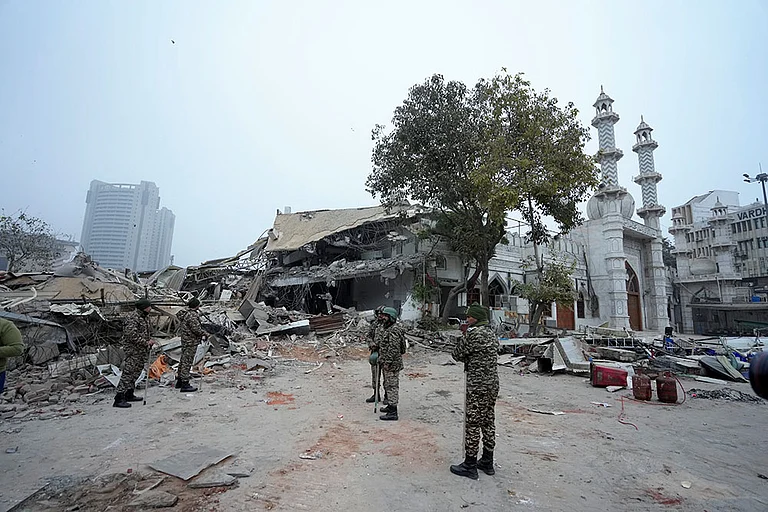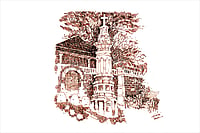Like death itself, death threats too have a way of slinking into one’s life. For 2014 Jnanpith award winner Bhalchandra Nemade, a death note came his way in the form of a scribbled scrap. It was slipped into his hands by an unknown person at a Sahitya Akademi function in Nagpur in 2015.
Nemade, along with noted writer and scholar Ganesh Devy, was sipping tea at the venue that day. Just two days before, Kannada scholar and rationalist M.M. Kalburgi had been gunned down by unknown youngsters at his home in Dharwad. Kalburgi’s wife Umadevi had stepped into the kitchen to fetch coffee for the soon-to-be killers of her husband, who had posed as students.
“I recall very clearly. We were having chai before the event was to begin. Somebody came and put a note in his hand. Nemade put the note in his pocket. Later, when he saw it, it was a threat,” Devy tells Outlook. Just two years earlier, Nemade, a renowned Marathi novelist, had authored Hindu: Jagnyachi Samruddha Adgal, whose release had led to protests by the Vishwa Hindu Parishad. His writing had critiqued Brahmin hegemony in Hinduism.

The death threat led to immediate police protection for Nemade. Others weren’t as lucky. Anti-superstition activist Narendra Dabholkar was shot dead when he was on a morning walk in 2013. Communist Party of India leader Govind Pansare too was shot during a morning walk in 2015, the same year when Kalburgi was gunned down. Journalist Gauri Lankesh was shot dead by assailants outside her home in Bangalore in 2017.
There were several commonalities in these high-profile murders. The victims were rationalists, shaped by Left ideology. According to several police agencies, including Karnataka Police’s SIT, which investigated some of the murders, the same 7.65 mm country-made pistol had been used to kill both Lankesh and Kalburgi. Multiple police investigations also claimed to have unearthed linkages between the spate of killings to some members of the Goa-based right-wing Hindu organisation, Sanatan Sanstha. The Sanstha denied involvement of its cadre in the deaths, in a previous interview to Outlook (We Are The Whipping Boys Now: Sanatan Sanstha National Spokesperson Chetan Rajhans).
ALSO READ: Salman Rushdie And The Iran Fatwa
According to Devy, Pansare’s murder triggered the formation of an association of writers and thinkers, the Dakshinayan Abhiyaan, to lobby and stand by them amid threats and duress. Circa 2015 represented a time when writers and artists across the country had spurred a trend of returning their State awards in protest against the central government’s silence on such violence.
According to Devy, the word dakshinayan itself has several connotations. One is “going south”, into the domain of the marginalised. “It is also a (astronomical) phase when nights are longer than days on account of the trajectory of the earth’s revolution around the sun. It refers to a period of depression, a period where worries are multiplied,” Devy says.
The Abhiyaan has members across the country and has organised protests and awareness programmes across India to campaign against intolerance, violence, government apathy, and to instil confidence and fearlessness among artists and writers.
Dabholkar, Pansare, Kalburgi and Lankesh weren’t the only writers or rationalists who were on the extremists’ radar. Chandrashekhar Patil, who died earlier this year, had also been threatened. Karnataka-based writer and translator K.S. Bhagawan, Marathi writers Sanjeev Khandekar, Rajan Khan, Anand Karandikar and Sandesh Bhandare, and a photojournalist from Pune are also reportedly on the threat radar.
A page from a diary seized from one of Lankesh’s killers was a hitlist with names of creative artists. Girish Karnad, who died in 2019 due to prolonged illness, topped the list. Lankesh was second. Pune-based poet Ganesh Vispute also featured on the list. He was provided police protection in 2018.
Vispute, who is part of the Dakshinayan Abhiyaan, says he has been vocal in his critique of governments, especially in view of “things which happened in the last 7-9 years”. “I wrote poems and returned my government award in 2015. That must be the reason. I do not know. But (they) can easily identify that you are not with them,” he says, while trying to spell out why he ended up on an assassin’s hitlist.
This year’s Jnanpith award winner Damodar Mauzo’s name had featured on the same hitlist found on Lankesh’s killer. Mauzo’s house is located in South Goa’s Majorda village. The beach village is from where centuries ago, the culture of fermenting dough and baking bread spread across Goa. His house is lined with tall plants, which shield the structure from the busy traffic along the railway track just a few metres away. The house floor itself has developed a crack from the vibrations caused by rumbling train rakes passing by, many of them laden with coal. Coal dust invariably seeps into the house. “It’s quite a menace,” Mauzo says, before he begins speaking on the other, more immediate menace that confronts him.
Even as Mauzo opens the door, one cannot but miss the two men lounging in a corner of the veranda, one of them wearing a full-sleeved shirt and leather shoes. The 78-year-old writer claims he feels secure in his village, with or without the security detail picketed at his home. But he is also of the belief that if someone is really keen on killing you, they’ll do it anyway.

He also has a theory about why writers like him find their names on the hitlist. Typically, for a Goan, he uses fish to illustrate his point. Small fish like him, Mauzo claims, are being used to threaten the big fish, who are difficult to target in a lethal assault. “I always try to think why they would think of hitting me. I think for them it is safer to hit low-key, less important people, so that the message gets sent across to their real targets,” says Mauzo.
An avowed atheist, Mauzo has earned accolades as a fiction writer. Some of his stories set in Goa and its spill-over geography deal with subjects like lynching over cattle transportation, and how a beef burger can define the dynamics of a friendship, much before beef and lynching became popular currency across India.
But he believes that his speeches at public fora, which critique intolerance and communalism, have irked those who now want to kill him and his ilk. “When I talk about, say, the Sanatani mindset or threats or strengthening of fundamentalism, they probably think I make others aware of it. So they want to stop me,” Mauzo said.
Mauzo also loves his morning walks, which incidentally have not been kind to Pansare and Dabholkar. The two rationalists were killed during their morning walks.
When Mauzo was first allocated State security, a motorcycle escort and a policeman with a rifle trailed him on his walks. After a while, the bike broke down and the policeman disappeared. One of Mauzo’s police escorts also could not keep pace with the author, who is known in his village for his brisk walk. Asked if he had received a direct threat over phone or by a cryptic message before or after his name appeared on the hitlist, Mauzo claims direct threats do not fit the killers’ pattern.
Devy says the death threats and repeated episodes of the intelligentsia being put under duress have sparked off a new literary trend, where the spotlight is more focussed on the excesses of a totalitarian State. “…after 2014, these Dalit writers were not just writing about resistance to caste discrimination, but to fascism. Similarly, feminist writers have turned their attention to the question of a totalitarian State, not just patriarchal society,” Devy says.
(This appeared in the print edition as "GUNS & PROSES")


























